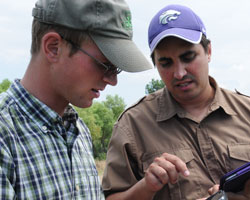Soybean Yield Calculator: A New Mobile App from K-State
July 29, 2015
 Photos and captions available
Photos and captions available
MANHATTAN, Kan. - A new mobile app for estimating soybean yields is now available from Kansas State University.
KSUSoyYieldCalc is a native Android application that helps with yield estimation of soybeans before harvest following the conventional approach of counting or estimating plant populations, pods per plant, seeds per pod, and seed size, said Ignacio Ciampitti, crop production specialist with K-State Research and Extension.
The calculator needs only four inputs for predicting the final yield.
1. Plant population. This component can be estimated by counting the number of plants in a 21-inch row length for 30-inch row spacings (1/10,000th of an acre), and by multiplying that number by 10,000. For example, 10 plants in the 21-inch length of row would be the equivalent of 100,000 plants per acre.
2. Pods per plant. This factor can be obtained by counting all pods per plant in the 21-inch row length.
3. Seeds per pod. A good average number is 2.5 seeds per pod, but the range available on the app is from 1 to 4 seeds per pod.
4. Seed size. Seed size typically ranges from 2,000 (large) to 3,500 (small) seeds per pound, with an average of 2,800 seeds per pound.
Seed size normally varies from 2,400 to 3,200 seeds per pound, depending on growing conditions, Ciampitti said.
“If the conditions until harvest will be favorable, then the seed size component should be a lower number to reflect a larger seed size. If conditions are likely to be unfavorable, resulting in a short seed-fill period, the ‘seed size per pound’ number entered into the calculator should be higher. Seed size will be ultimately determined as the crop approaches maturity, but an estimation is needed considering the importance of this factor for influencing final soybean yields,” he said.
The coding for the KSUSoy YieldCalc app was developed by Tania Bandyopadhyay, graduate student in K-State’s Department of Computing and Information Sciences (CIS), under the supervision of Dan Andresen, associate professor of CIS, in collaboration with Ciampitti.
Downloads are free and can be downloaded from the Google Play link.
Go to the above link or search for “soybean yield” within the Google Play website and download the application, Ciampitti said.
-30-
Story by:
Steve Watson
swatson@ksu.edu
K-State Research & Extension News
For more information:
Ignacio Ciampitti is at 785-532-6940 or ciampitti@ksu.edu
